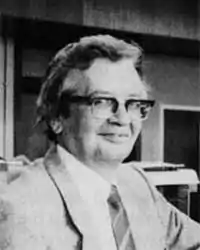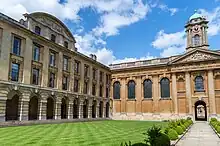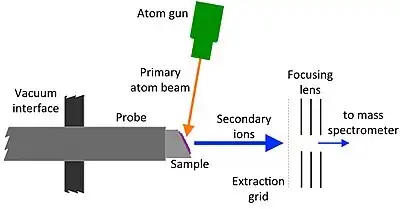Michael Barber | |
|---|---|
 | |
| Born | 3 November 1934 Newton, Greater Manchester, England |
| Died | 8 May 1991 (aged 56) |
| Other names | Micky |
| Alma mater | Manchester Grammar School, Queen's College, Oxford |
| Known for | Fast atom bombardment |
| Spouse | Joan Barber (m. 1958; died 1991) |
| Children | 3 |
| Scientific career | |
| Fields | Chemistry, mass spectrometry |
| Doctoral advisor | John Wilfrid Linnett |
Michael (Mickey[1]) Barber, FRS (3 November 1934 – 8 May 1991) was a British chemist and mass spectrometrist, best known for his invention of fast atom bombardment ionisation.[2][3]
Biography

On 3 November 1934, Barber was born at his family's home in Manchester at 166 Lodge Lane in Newton. His family were working-class and underprivileged. Barber was one of two boys; his brother Peter was born in 1927. His father, Joseph Barber, was a carpenter.[4]
He went to Manchester Grammar School[1] and was then educated at the Queen's College, Oxford, obtaining his B.A. in 1958 and his B.Sc. in 1959. There he worked with Jack Linnett and they designed and built a mass spectrometer for the analysis of flames. He married Joan Gaskell in 1958, the couple had three children.[4]
In 1961 he returned to Manchester to work at the Scientific Instruments division of Associated Electrical Industries. There, he and Martin Elliott developed a method to study the fragmentation of ions with a mass spectrometer and started to work on X-ray photoelectron spectroscopy. In 1973 he took up a lectureship position at UMIST and was promoted to Professor in 1985. In the same year, 1985, he was also elected a Fellow of the Royal Society. He remained at Manchester until his death.[5]
Fast atom bombardment

Fast atom bombardment (FAB) is a method of ionization used in mass spectrometry that uses a beam of high energy atoms strikes a surface to create ions.[6][7][8] An energetic beam of atoms or ions will destroy an organic molecule under conditions typically used to create secondary ions. Barber realised that mixing the compound of interest with a vacuum compatible low-volatility liquid such as glycerol effectively protected the organic molecule and allowed it to be ionized and detected.[3][9] The protecting liquid "matrix" allowed compounds as large as 10,000 Da molecular mass to be detected. The concept of a protecting matrix was later used in matrix-assisted laser desorption ionization.[10] The FAB technique was employed by Barber, Howard Morris (biochemist) and co-workers for early peptide sequencing experiments.[6]
Honours and distinctions
- Royal Society of Chemistry Award for analytical chemistry and instrumentation (1979)[4]
- Fellow of the Royal Society (1985)[4]
- American Society for Mass Spectrometry – The Distinguished Contribution in Mass Spectrometry Award (1991)[4]
The Michael Barber Centre for Collaborative Mass Spectrometry, based at the University of Manchester, is named in honour of him.
References
- 1 2 Nier, Keith A.; Yergey, Alfred L.; Jane Gale, P. (6 May 2015). The Encyclopedia of Mass Spectrometry. Elsevier Science. ISBN 9780081003794.
- ↑ Ronald Reid (12 November 1999). Peptide and Protein Drug Analysis. CRC Press. pp. 529–. ISBN 978-1-4200-0133-4.
- 1 2 Green, Brian N. (1992). "In Memory: Professor Michael Barber FRS". Organic Mass Spectrometry. 27 (1): 67. doi:10.1002/oms.1210270119. ISSN 0030-493X.
- 1 2 3 4 5 Beynon, John Herbert (1 November 1996). "Michael Barber, 3 November 1934 - 8 May 1991". Biographical Memoirs of Fellows of the Royal Society. 42: 2–9. doi:10.1098/rsbm.1996.0001. S2CID 71325506. Retrieved 17 August 2020.
- ↑ "Professor Michael Barber FRS. Born 3 November 1934; died 8 May 1991". Rapid Communications in Mass Spectrometry. 5 (7): 340–342. 1991. Bibcode:1991RCMS....5..340.. doi:10.1002/rcm.1290050709. ISSN 0951-4198. PMID 1841652.
- 1 2 Morris HR, Panico M, Barber M, Bordoli RS, Sedgwick RD, Tyler A (1981). "Fast atom bombardment: a new mass spectrometric method for peptide sequence analysis". Biochem. Biophys. Res. Commun. 101 (2): 623–31. doi:10.1016/0006-291X(81)91304-8. PMID 7306100.
- ↑ Barber, Michael; Bordoli, Robert S.; Elliott, Gerard J.; Sedgwick, R. Donald; Tyler, Andrew N. (1982). "Fast Atom Bombardment Mass Spectrometry". Analytical Chemistry. 54 (4): 645A–657A. doi:10.1021/ac00241a817. ISSN 0003-2700.
- ↑ Barber M, Bordoli RS, Sedgewick RD, Tyler AN (1981). "Fast atom bombardment of solids (F.A.B.): a new ion source for mass spectrometry". Journal of the Chemical Society, Chemical Communications (7): 325–7. doi:10.1039/C39810000325.
- ↑ Gaskel, Simon J.; Gale, P. Jane (4 December 2015). Richard M. Caprioli (ed.). The Encyclopedia of Mass Spectrometry: Volume 9: Historical Perspectives, Part A: The Development of Mass Spectrometry. Michael L. Gross. Elsevier. pp. 11–12. ISBN 978-0-08-091325-4.
- ↑ Hillenkamp, Franz; Karas, Michael; Beavis, Ronald C.; Chait, Brian T. (1991). "Matrix-assisted laser desorption/ionization mass spectrometry of biopolymers". Analytical Chemistry. 63 (24): 1193A–1203A. doi:10.1021/ac00024a716. ISSN 0003-2700. PMID 1789447.
External links
- Barber, Michael; Bordoli, Robert S.; Sedgwick, R. Donald; Tyler, Andrew N. (1981). "Fast atom bombardment of solids (F.A.B.): a new ion source for mass spectrometry". Journal of the Chemical Society, Chemical Communications (7): 325. doi:10.1039/c39810000325. ISSN 0022-4936.
- Michael Barber Centre, University of Manchester
- Advances in Mass Spectrometry (Waldron, J. D)